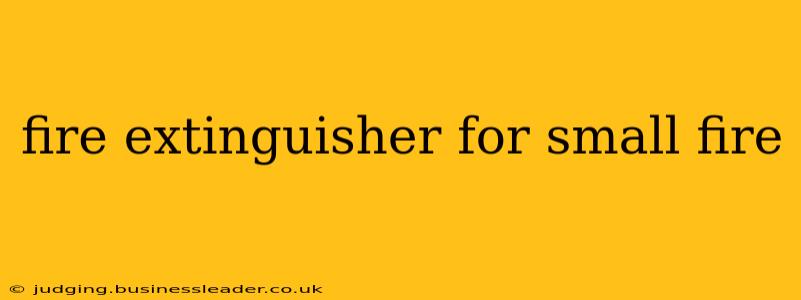Small fires can quickly escalate into significant emergencies, causing property damage and even posing a threat to life. Knowing which type of fire extinguisher to use is crucial for effectively tackling these incidents. This guide will help you understand the different classes of fires and the best fire extinguisher types for small fire situations. We'll also address frequently asked questions surrounding fire extinguisher selection and usage.
What are the Different Classes of Fire?
Before selecting a fire extinguisher, it's vital to understand the different classes of fires. Each class requires a specific type of extinguisher for safe and effective suppression.
- Class A: These fires involve ordinary combustible materials like wood, paper, cloth, rubber, and many plastics. They are characterized by the presence of ash.
- Class B: These fires involve flammable liquids like gasoline, oil, grease, and other petroleum products. They are often characterized by a fast-spreading flame.
- Class C: These fires involve energized electrical equipment, such as appliances, wiring, and electrical panels. Never use water on a Class C fire.
- Class D: These fires involve combustible metals like magnesium, titanium, and sodium. These require specialized extinguishers and are beyond the scope of typical household fire safety.
- Class K: These fires involve cooking oils and fats in commercial kitchens. These fires require specific extinguishers designed for this type of fuel.
What Type of Fire Extinguisher is Best for Small Fires?
For small household fires, a multi-purpose ABC fire extinguisher is generally recommended. These extinguishers are effective against Class A, B, and C fires, providing versatile protection for most common household fire scenarios. The size of the extinguisher should be appropriate for the potential fire size; a larger extinguisher might be needed for larger homes or businesses. Always check the extinguisher's pressure gauge to ensure it's fully charged before use.
How Do I Use a Fire Extinguisher?
Remember the acronym PASS when using a fire extinguisher:
- Pull the pin.
- Aim at the base of the fire.
- Squeeze the lever.
- Sweep from side to side.
What Size Fire Extinguisher Do I Need?
The size of the fire extinguisher you need depends on the size of the area you're protecting and the potential fire hazards present. Larger homes or businesses will require larger extinguishers. Check local fire codes and regulations for specific requirements. A 2A10BC extinguisher is a common size for home use, but bigger might be better in certain situations.
How Often Should I Inspect My Fire Extinguisher?
Regular inspection is crucial. Visually inspect your fire extinguisher monthly to ensure it's properly charged and there's no damage. Have it professionally inspected and serviced annually by a qualified technician.
Where Should I Place My Fire Extinguishers?
Place fire extinguishers in readily accessible locations, away from potential fire hazards but close enough to be quickly reached in case of an emergency. Keep them in a visible and easily accessible location.
What are the Different Types of Fire Extinguishers?
Beyond the ABC extinguisher, several other types exist, each designed for specific fire classes:
- Water (Class A): Effective against ordinary combustible materials.
- Carbon Dioxide (Class B, C): Effective against flammable liquids and energized electrical equipment. Leaves no residue.
- Dry Chemical (Class A, B, C): Effective against a range of fire classes.
What Should I Do if a Fire Gets Too Big?
If a fire grows beyond your ability to control it with a fire extinguisher, evacuate immediately and call emergency services (911 or your local equivalent). Never attempt to fight a large or rapidly spreading fire. Your safety is paramount.
This guide provides essential information on choosing and using fire extinguishers for small fires. Remember, prevention is key—regularly check smoke detectors, keep flammable materials stored safely, and practice fire safety procedures to minimize the risk of fire. Always consult local fire safety regulations and seek professional advice when necessary.
